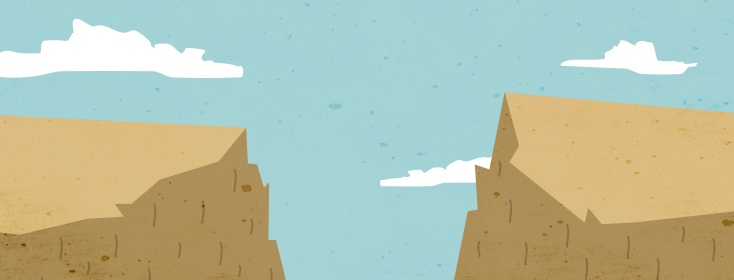The RA Divide
Recently I went to pick up my kids from preschool, and was feeling really achy. There had been a series of storms and temperature fluctuations all week, and the shifts in barometric pressure had ramped up my rheumatoid arthritis symptoms. On my way into the building I ran into a new friend, who asked how I was doing. Whenever I’m achy and someone says, “How are you?” I’m faced with the decision to lie in the name of pleasant small talk or to be honest and risk making things uncomfortable. As this is a person I could see becoming a good friend, I opted for honesty and told her I was having a hard time and wasn’t feeling great because of the weather’s impact on my rheumatoid arthritis. In a genuine effort to be helpful, she asked, “Can you take an ibuprofen?” I responded, “Yes, I’ve been taking 800mg of ibuprofen every eight hours for the past few days.”
Moments like this bring into sharp focus what I call “the RA divide.” On one side are those of us who live with this disease and struggle through its quirks and challenges on a daily basis. On the other side are the majority of people, those who have no idea what it’s like to have RA. While some of those people are inconsiderate or uncaring, many if not most of them are like my friend, who does care about what I’m going through but has no context to understand it. I can’t blame her; until I was searching for the cause of all the pain, swelling, and fatigue that came down on me like a ton of bricks when I was 22 years old I had no idea that young people could get arthritis, much less understand that RA is an autoimmune condition. Heck, I’m not even sure I could have told you exactly what an autoimmune condition was. I’d heard the term plenty of times, as my sister was diagnosed with type 1 diabetes when I was in kindergarten. While I understood that her pancreas doesn’t produce enough insulin and that because of that her life has to be structured around trying to maintain healthy blood sugar levels, I didn’t understand that it was her own immune system that was attacking the cells in her pancreas and preventing them from producing the insulin she needs to live and thrive. I was on the other side of the divide.
For years now I’ve been on this side of the rift, understanding all too well that the very system of my body that is supposed to be my protector, my warrior against harmful intruders, has turned traitor and taken up arms against my joints. I know that flares are inconsistent and unpredictable, although I have become aware of several triggers, such as over-exertion, barometric pressure changes, and too little sleep, that are likely to cause a flare. I also know that while I may appear completely healthy to an untrained eye, there is a process of swelling and reabsorption of that inflammation that is slowly eating away at my joints. And I know all too well that the pain of rheumatoid arthritis can be so intense and so pervasive that even high doses of ibuprofen aren’t going to touch it.
When I’m caught in moments such as that, standing two feet away from someone who I want to feel connected to, yet suddenly realizing there’s a huge chasm between us, I’m faced with the isolation that rheumatoid arthritis can pile on top of the pain and swelling. I’m slightly amazed at how truly foreign my every day experience is to so many people with whom I have much in common. I’m left wondering if maybe it is better just to lie by giving the standard, “I’m fine. How are you?” response. In those moments I’m faced with just how ugly my experience can be, and I’m left fearing that those on the other side of the divide might want nothing to do with it. Part of me wouldn’t blame them. For while I think that I have enough personality to make up for the bummer that is my health condition, I would love to have the luxury of blissful ignorance of this disease.

Join the conversation